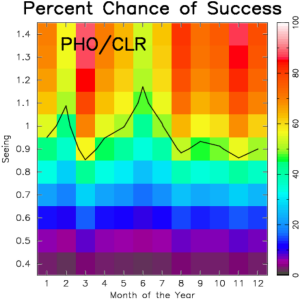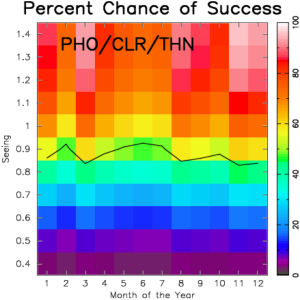Observing conditions: definitions
The following definitions of the observing conditions are common between Phase 1 preparation and Phase 2 preparation, as well as between Service Mode and Visitor Mode observations. These basic definitions are listed below. Please use the instrument selector on the right to see instrument-specific information at the bottom of the page. There are additional Service Mode Policies and Service Mode Guidelines regarding the observing conditions.
Observing conditions (Sky Transparency, Moon, PWV, as well as Turbulence Category, and Image Quality) are defined as follows:
- Sky Transparency
- Photometric: No visible clouds, transparency variations under 2%, only assessable by the analysis of photometric standard stars.
- Clear: Less than 10% of the sky (above 30 degrees elevation) covered in clouds, transparency variations under 10%.
- Thin cirrus: transparency variations above 10%.
- Moon
- Moon constraints include the fraction of lunar illumination (FLI) and the moon distance.
- Moon illumination (fraction of lunar illumination, FLI) is defined as the fraction of the lunar disk that is illuminated at local (Chile) civil midnight, where 1.0 is fully illuminated. By definition, moon illumination equals 0 when the moon is below the local horizon.
- Lunar illumination does not have a noticeable influence on the feasibility of infrared observations.
Important note on the moon distance constraint for optical wavelengths:
At the dry, low water vapour site of Paranal during clear or photometric nights we expect that the night sky brightness does not show a strong dependence of the lunar distance (Rayleigh scattering I ~ I0 × (1 + cos2Θ),
http://en.wikipedia.org/wiki/Rayleigh_scattering)
Measurements performed on Paranal in I-band during bright time have shown that the sky brightness is approximately constant for moon distances >~50deg. Hence, defining a moon distance constraint larger than 50 deg for I-band observations are unnecessarily limiting the time available for the execution. Observations at shorter wavelengths (B- to R-band) in grey and dark time are also not affected very much by the presence of the moon if the distance is >~50-60 deg, and often the sky is darker at 60-70 deg away from the moon than at 120 deg away, when the moon is low above the horizon (see Fig 5 of Patat 2004, Messenger Issue 118)For observations in optical wavelengths it is advised to select moon distance up to 60-70 degrees. Selecting larger lunar distances may drastically reduce the gray/dark time periods in which the observations can be carried out.
- Moon constraints include the fraction of lunar illumination (FLI) and the moon distance.
- Precipitable Water Vapour (PWV)
- Acceptable upper limits for the PWV must be specified for all instruments in the new p1 proposal submission system, when defining the corresponding observing run. The default values are 10mm for VISIR, 20mm for KMOS, and 30mm for all other Paranal instruments. These defaults should be fine for all non-IR instruments and in any event can be lowered if required for the science. The impact of the PWV can be evaluated with Exposure Time Calculators (ETCs).
Please note that these observing conditions requested at Phase 2 should match those at Phase 1 (see Service Mode Policies).
- Turbulence Category, Image Quality, and their usage at Phase 1 and Phase 2 are defined as follows:
- As a preface, seeing is an inherent property of the atmospheric turbulence, which is independent of the telescope that is observing through the atmosphere outside the dome. The seeing values in the table and figure below are measured in the V band at zenith.
- Image Quality (IQ), defined as the full width at half maximum (FWHM) of long-exposure stellar images, is a property of the images obtained in the focal plane of an instrument mounted on a telescope observing through the atmosphere. It is therefore a quantity measured at the (requested) airmass and wavelength of observation.
- Turbulence Category
- Starting with Phase 1 of ESO Period 105 (Sept 2019), we introduce a new constraint, the atmospheric turbulence constraint. This constraint generalizes the classical seeing constraint used so far, and takes into account the coherence time and the fraction of turbulence in the ground layer, for instruments that need it, in addition to the classical seeing. These additions are important constraints for instruments using adaptive optics (AO) and need to be taken into account when scheduling observations to ensure that the science goals can be achieved. In order to harmonize this new scheme between all non-AO and AO instruments, a single Turbulence Category is introduced at Phase 1 for all instruments.
- Turbulence Category at Phase 1 for any instrument: At Phase 1, the classical seeing constraint is replaced by the choice of the Turbulence Category for all instruments. The Turbulence Category is defined by its probability of occurrence, from 10%, meaning the top 10% of the best conditions in La Silla or Paranal (the most demanding category), to 100% meaning any conditions. The following 7 Turbulence Categories have been defined allowing one to select from a range of good turbulence conditions as appropriate and encouraging requests for demanding science cases:
Turbulence Category
(name and probability)10% 20% 30% 50% 70% 85% 100% - Turbulence Category at Phase 1 for instruments without AO system: For instruments without AO systems, for which the only relevant turbulence parameter is the classical seeing (i.e. for Paranal: UVES, FLAMES, XSHOOTER, FORS2, KMOS, MUSE WFM without AO, HAWKI without AO, CRIRES without AO VISIR, ESPRESSO, VIRCAM, and VISTA), each Turbulence category can therefore be associated to a unique seeing upper threshold. These thresholds have been computed using the cumulative distribution of the seeing assuming on average 1h long observations:
Turbulence Category 10% 20% 30% 50% 70% 85% 100% Seeing threshold 0.5" 0.6" 0.7" 0.8" 1.0" 1.3" all
These 7 Turbulence Categories are shown graphically in the Figure below along with the cumulative distribution of the seeing computed after applying a rolling 90-th percentile over 1h:

We note that already since ESO Period 96 (Apr 2015), we differentiate between seeing at Phase 1 and image quality at Phase 2. The article by Martinez et al. entitled "On the Difference between Seeing and Image Quality" in Volume 141 of the ESO Messenger describes the meaning of these two quantities.
- Starting with Phase 1 of ESO Period 105 (Sept 2019), we introduce a new constraint, the atmospheric turbulence constraint. This constraint generalizes the classical seeing constraint used so far, and takes into account the coherence time and the fraction of turbulence in the ground layer, for instruments that need it, in addition to the classical seeing. These additions are important constraints for instruments using adaptive optics (AO) and need to be taken into account when scheduling observations to ensure that the science goals can be achieved. In order to harmonize this new scheme between all non-AO and AO instruments, a single Turbulence Category is introduced at Phase 1 for all instruments.
- Note that the same Phase 2 IQ at different bands may correspond to different seeing, and thus Turbulence Categories to be requested at Phase 1. In this case, please request the most stringent Phase 1 Turbulence Category. The instrument ETCs can be used to establish the correspondence between the desired Image Quality and the Turbulence Category to be requested at Phase 1.
- Turbulence category (T category) at Phase 1 for instruments with AO system: For AO instruments for which the performance depends on other parameters than the pure seeing (i.e. for Paranal: SPHERE, GRAVITY, MATISSE, PIONIER, MUSE-NFM, MUSE-WFM-AO, HAWKI with AO, CRIRES with AO) the user should refer to the ETC to find out the category to request to reach the required performance. The definition of each category in terms of turbulence conditions (seeing, coherence time if relevant, ground-layer fraction if relevant, isoplanatic angle if relevant) can be found in the User Manual and/or instrument webpages of the respective instruments.
- Turbulence category or Image Quality at Phase 2?
- Instruments without AO systems or with ground layer AO systems (MUSE WFM-AO and HAWKI+GRAAL): the image quality (IQ) remains the constraint for Service Mode Phase 2 Observation Blocks (OBs) and there is no change with respect to past observing periods. Quality control grade A is assigned to executed OBs if constraints are fully met, and they are graded B if the measured IQ is violated up to 10%. If constraints are violated by more than 10% within the 1h of the start of observation, the quality grade will be C and the observation will be repeated.
With the help of the Exposure Time Calculators (ETCs) the requested Phase 1 V-band seeing at zenith can be transformed into the desired IQ at the observed wavelength and airmass for each instrument.
- Instruments with AO systems (SPHERE, MUSE NFM, CRIRES, VLTI instruments): the same Turbulence Categories as defined at Phase 1 are used at Phase 2. An observation will be considered successfully executed if the turbulence conditions associated to this Turbulence Category are met during the observation. More precisely, if the constraints are met during 90% of the time, the quality grade of the observation will be A. If the constraints are met during 50% of the time, the quality grade will be B. In other cases, the quality grade will be C and the observation will be repeated.
- Instruments without AO systems or with ground layer AO systems (MUSE WFM-AO and HAWKI+GRAAL): the image quality (IQ) remains the constraint for Service Mode Phase 2 Observation Blocks (OBs) and there is no change with respect to past observing periods. Quality control grade A is assigned to executed OBs if constraints are fully met, and they are graded B if the measured IQ is violated up to 10%. If constraints are violated by more than 10% within the 1h of the start of observation, the quality grade will be C and the observation will be repeated.
Please note that while for each instrument/mode the constraint specification at Phase 1 is the Turbulence Category, at Phase 2 the corresponding constraint is (instead) as specified in the table below (Turbulence Category or Image Quality), depending on instrument and AO mode. In any event, the specification at Phase 2 should be no tighter than the Phase 1 specification (see Service Mode Policies).
The correspondence between Phase 1 and Phase 2 characterisations of the Turbulence Category and Image Quality follows this table, where the definitions of Turbulence Category and Image Quality are as described above
| ERIS | HAWK-I | MUSE | SPHERE | CRIRES | VLTI | Other | ||
|---|---|---|---|---|---|---|---|---|
| Phase 1 | Turbulence Category | Turbulence Category | Turbulence Category | Turbulence Category | Turbulence Category | Turbulence Category | Turbulence Category | |
| Phase 2 | No-AO | Image Quality | Image Quality | Image Quality | N/A | Image Quality | N/A | Image Quality |
| GLAO | N/A | Image Quality | Image Quality | N/A | N/A | N/A | N/A | |
| Full-AO | Turbulence Category | N/A | Turbulence Category | Turbulence Category | Turbulence Category | Turbulence Category | N/A |
The two figures below show the percent chance of realisation of combined sky transparency (clear sky or better left; thin clouds or better on the right) conditions and instantaneous measurement of different seeing values, across the year at Paranal. The black line through the middle represents the 50% chance of realisation. See also the Messenger article "Fifteen Years of Service Mode Operations: Closing the Loop with the Community" by F. Primas et al. (2015).
Instrument selector


